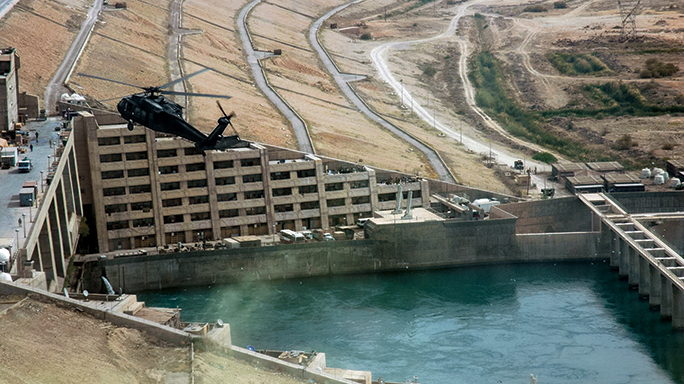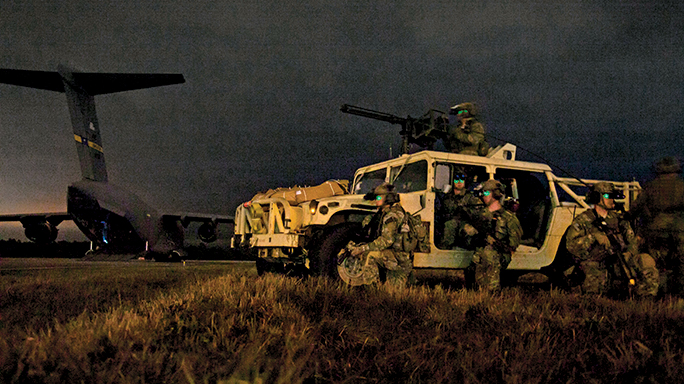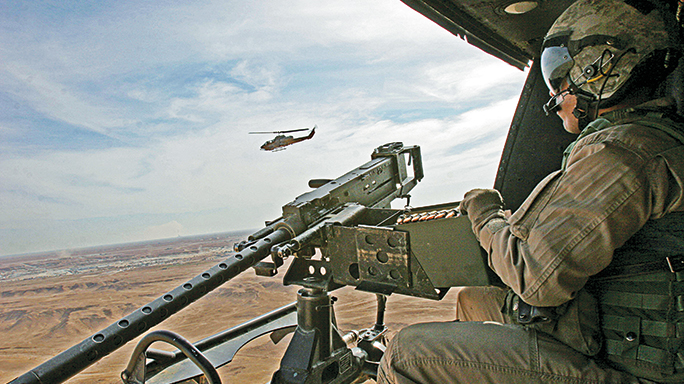A company of Army Rangers was in the early stages of a mission in the Iraqi desert when its orders were suddenly changed, and the troops were instructed to take and hold the Haditha High Dam, a critical piece of the Iraqi infrastructure along the Euphrates River.
Given the increased scope of the mission, the company received an additional platoon as well as a pair of sniper teams, a physician’s assistant, and an Air Force combat controller to assist in calling down the substantial air support needed during the mission. The force would finally number 154 men.
- RELATED STORY: Operation Red Wings: The ‘Lone Survivor’ Story
Capt. David Doyle quickly formulated a strategy, and by 11 p.m. on March 31, 2003, the team was aboard the Humvees and rapidly covering the 33 miles to the dam. The plan was for the company to eventually split into three groups: One would secure the southwest corner of the dam where the company breached the perimeter fence; a second would drive along the road on top of the dam and eventually secure the northeast corner; a third would clear so-called Objective Cobalt, which included the power station control buildings and transformer yard at the base of the dam.
Advertisement — Continue Reading Below
The perimeter fence was easily breached as expected, the southwest corner of the dam was under control, and the second group rapidly advanced along the top of the dam.
Moving at speeds of up to 40 miles per hour and taking great advantage of their night-vision goggles, the Rangers captured several Iraqis in the process of securing the southeast corner. (The Iraqi insurgents were all facing in a southeast direction toward the Euphrates River, so an approach from the west made the most sense.) Part of this second group split off to clear the administration building, undertaking a laborious room by room search that took four hours.
A complicating factor was the fact that the group ran out of breaching charges, and then out of shotgun shells, forcing the Rangers to resort to rather unusual means to break down the doors.
Advertisement — Continue Reading Below
“With no charges or shotgun shells left,” one Ranger recalled, “we turned to having a couple of guys throw a fully loaded Ranger with body armor against the doors to knock them down. A couple of us got mighty sore doing it, but we eventually got the job done.”
Eventually the soldiers found 25 civilian workers, who were taken into custody.
The Rangers on top of the dam were now beginning to take fire, RPGs in particular. A sniper solved that problem when he took out the enemy team of three insurgents with a single bullet from an astounding distance of more than 1,000 yards that went through one of the Iraqis and into a propane tank, blowing up and killing the other two enemy combatants.
Advertisement — Continue Reading Below
With the southern side of the dam now securely in American hands, the group moved to the northeastern corner, where, as expected, the Rangers began meeting increasing resistance, including a truck carrying 14 armed Iraqi insurgents. The Rangers killed five of them almost immediately with .50-caliber machine gun fire, then defeated the remainder of the enemy force in an hour-long firefight, after which two Rangers rescued three wounded Iraqis who had tumbled down a hill while under fire.
With the northeast corner now secured, the third Ranger group moved down a steep access road to the buildings and transformer yard of Objective Cobalt at the river level at the base of the dam.
Iraqi resistance from two buildings in particular was fierce, causing the Rangers to call in a total of 20 bombs that eventually eliminated the problem. Still the Iraqis kept charging back in waves of 50 to 100 soldiers before being repelled by 120 mm mortar tubes, surgical airstrikes, and effective fire from smaller arms. These insurgent waves continued almost every 30 minutes over the next two days.
Advertisement — Continue Reading Below
The Rangers on top of the dam were suddenly facing stiffer Iraqi resistance as well, with 10 Iraqi mortar tubes and numerous RPG launchers and machine guns now directed at them. Air strikes and accurate return fire kept the Iraqis at bay, but the shelling continued for days.
Perhaps the greatest challenge the Rangers faced was sheer fatigue—combat fatigue, in particular—as they fought on and on over the next several days with no sense of certainty about when reinforcements might arrive. (They were originally promised for the end of April 1, the first day of intense fighting.)
Late on April 2, the Iraqis began bombarding the Rangers with the first of more than 350 155 mm artillery shells, a barrage that would last for nearly 36 hours. Through painstaking visual identification of enemy positions and subsequent airstrikes directed against them, the Rangers were eventually able to stop the barrage late on April 3, and by April 5, the Iraqi resistance had dissipated almost completely, allowing the Rangers to extend the perimeter several thousand yards down the river from the dam.
Advertisement — Continue Reading Below
On April 6, at long last the reinforcements began arriving, and on April 8, the utterly exhausted Rangers, who had amazingly suffered only four casualties, none of them deadly, were finally transported out of the area. The damage inflicted on the insurgents was substantial: 24 Iraqi mortars, 28 155 mm artillery pieces, 23 AAA guns, 29 tanks, and three trucks were destroyed, and an estimated 300 to 400 enemy fighters were killed.
- RELATED STORY: Land, Air & Sea: How Special Forces Get the Job Done
The official Army history of the encounter described the capture of Haditha High Dam as “one of the most impressive examples of direct action by SOF [special operations forces] units ever executed … Haditha Dam was executed with thunderclap surprise and audacity worthy of those who came before and wore the title of ‘Ranger.’”
Just The Facts
Advertisement — Continue Reading Below
Dates: April 1–8, 2003
Location: Haditha High Dam, some 185 miles northwest of Baghdad, Iraq
U.S. Forces: Army Rangers
Advertisement — Continue Reading Below
Enemy/Target: Haditha High Dam
Equipment: Full range of combat weaponry and a mixed collection of cargo and heavily armed HMMWVs (High Mobility Multi-purpose Wheeled Vehicles), aka Humvees


























